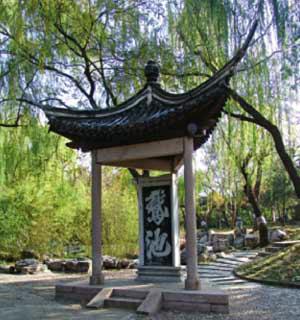A Joyful Park in Beijing
2017-07-21ByBRIANSALTER
By+BRIAN+SALTER
ONE of the things I like best about Bei- jing is its preponderance of beautiful parks. One that is less well known by western visitors is called Taoranting(陶然亭公園), which lies due west of the Temple of Heaven. Constructed in 1952 and opened in 1956, Taoranting was the earliest modern city park built after the establishment of the Peoples Republic. Some 60,000 visitors come here every day.
The park gets its name from the Taoran Pavilion (“Taoran” translates as “Joyful” in Chinese), which was built in 1695, and which is officially one of Chinas four famous historical pavilions(together with Aiwan Pavilion in Changsha, Zuiweng Pavilion in Chuzhou, and Huxin Pavilion in Hangzhou). The construction of the pavilion was overseen by Jiang Zao (江藻), who named the pavilion “Taoran” from a line of verse in a poem by Tang Dynasty poet Bai Juyi: “When the chrysanthemums are yellow and home-made wine is mature, Ill drink with you and be joyful.” (更待菊黄家酿熟,与君一醉一陶然).
Taoran Pavilion is part of Cibei Temple which is in the center of one of the lakes and was built more than 700 years ago in the Yuan Dynasty (1271-1368). Its museum contains many cultural relics, including some stone stele inscriptions and a num- ber of historical relics dating back to the Warring States (475-221 BC).
Scholars often frequented this pavilion, gathering there to recite and compose poetry and essays. In the 20th century several famous revolutionaries were closely associated with the Taoran Pavilion. At the end of the Qing Dynasty (1644-1911) Kang Youwei, Liang Qichao, and Tan Sitong came here to plan the Reform Movement of 1898. In the early years of the Republic of China period (1912-1949), Sun Yat-sen attended political meetings in the pavilion. On the afternoon of August 6, 1920, five progressive societies from Beijing and Tianjin held a joint meeting in the pavilion which was attended by Zhou Enlai and Li Dazhao. The tombs of the revolutionaries Gao Junyu and Shi Pingmei are on the northern side of the Central Island.
In imperial times the scenery was not particularly attractive. To the north of the pavilion was a residential district of single-story dwellings and to the east a group of desolate tombs. To the south stood the bare city walls and to the west a stretch of shallow water filled with reeds. In fact, up until the founding of the Peoples Republic in 1949, it was little more than a breeding ground for flies and mosquitoes.
The new Peoples Government transformed the stagnant swamp into three lakes – East Lake, West Lake and South Lake – which are spectacular all year round with their three-arch bridges and weep-ing willows by the waters edge. The earth dredged out was heaped up to form seven small hills on the lakes perimeter, and these were then planted with flowers, trees and shrubs. Now, of its 146 acres, 30 percent of the park is made up of lakes. In winter the lake freezes over and man-made snow is added to one small area to create an artificial ski slope.
In common with other Chinese parks, this one also has a “park within a park” – Huaxia Mingyuan(The China Garden of Famous Pavilions), which was opened to the public in 1985. The mini-park contains 36 pavilions in all, 10 of which are fullsized replicas of famous pavilions in 10 Chinese cities. I particularly like the E-Chi Stele Pavilion, which is the only three-cornered one there, though some of the grotto effects are a little less appealing, and more on the contrived side, but not at all unpleasant.
One of the things I also love about Chinese parks is the way people come together to sing and dance and practice traditional Chinese martial arts such as tai chi. Regular dancing is carried out here by the Uygur community and their colorful costumes are delightful as they swirl around to the accompaniment of the ethnic music blasting out from small loudspeakers.
All in all, Taoranting is a joyful park to experience at any time of the year; and at only RMB 2 to get in, it has to be one of the best value places to visit in the entire capital.
